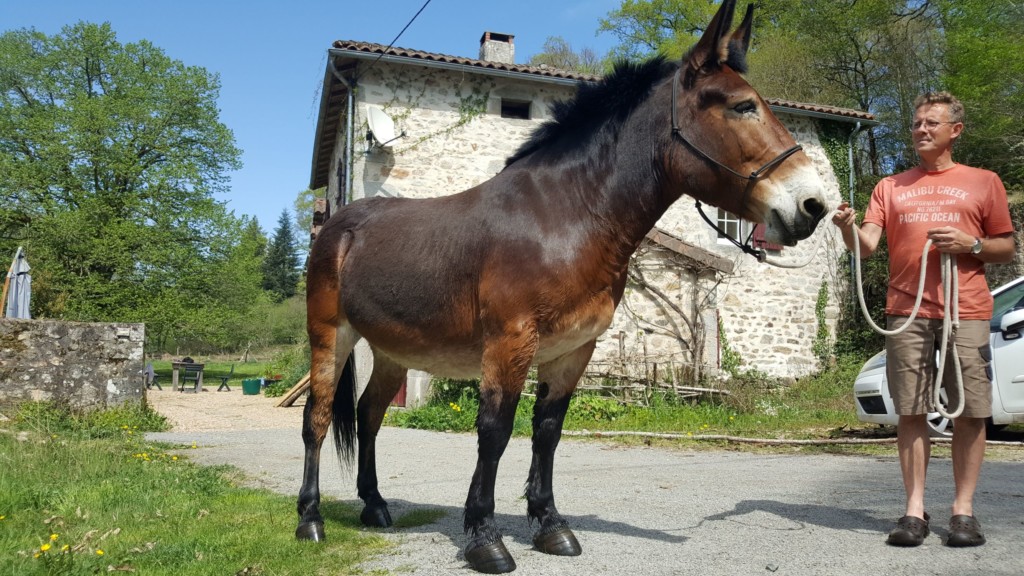We love mules, donkeys and horses
How we acquired our mule
What is a mule?
We are often asked what is a mule? A mule is the offspring of a male donkey and a female horse, the obverse of that coupling gives a hinny. Mules and hinnies are in themselves sterile so you cannot breed mules from mules (it’s a chromosome thing). Tina is a draft or draught mule which means her mother was a heavy horse of some kind – a cheval de trait in French. This is where her power and … ahem…heavy build comes from. Perhaps an Auvergne or a Breton breed of horse. One assumes her father was a pretty sizeable donkey or he would have had to stand on a box!
Mules are the most common and widely used hybrid that man has created and were thought to have originally been bred in north western Turkey over 5000 years ago. Mules, rather than camels, were used as transport from the turquoise mines of ancient Egypt and to the north in Asia Minor the Hittites considered the mule to be at least three times more valuable than a good chariot horse. To understand why, you need to understand a bit about donkeys and horses.
Donkeys are thinkers, they have to be. They live in small family groups within a territory. They, like horses, are prey animals but do not posses the speed or lung capacity to outrun a predator that a horse does. Also they are far more likely to be very closely related to the donkey next to them than a horse in a large herd and so have a vested interest in making sure the group survives.
Horses just need to be quicker than their neighbour to ensure survival. When spooked, a horse will run 500 metres before asking “what was that?”. A donkey will run 5 then turn and face the problem before deciding what to do. Donkeys are more likely to fight than flee and are still used today around the world to protect other livestock from predators.
A mule benefits from traits from both parents. It too is a “thinker” leading to the misplaced opinion that they are stubborn. They have their father`s sense of self-preservation – they will not put themselves in the way of harm. A well-trained horse can be ridden off a cliff – the more circumspect mule or donkey will firmly decline the invitation to plunge to its death. They benefit too from “hybrid vigour”. They are generally larger than both parents and, pound for pound, stronger. Mules also need less food and water than a horse and yet can generally outsprint a horse over a short distance.
In the medieval period mules were the favoured riding animal of clergy and the upper classes as they were quite the status symbol – the Mercedes of their time, if you like. By the 18th century France, Spain and Italy were all becoming mule breeding hubs. A thriving business grew up exporting mules to the nascent USA as settlers drove wagon trains westward. In the deserts of Utah testimony is found to the mule`s endurance as a freight animal in the skeletons left behind on the trails. Horses and oxen died in huge numbers forging westward but very few mule skeletons were found.
George Washington started his own mule breeding program as he saw them as the animal to drive the rural American economy forward after the revolution. By 1808 the U.S. was estimated to have 855,000 mules working across the country. Their endurance became the stuff of legend. In 1882 a company of scouts placed a 100lb (45Kg) load on a mule and marched it 280 miles in 3 days. Another pack train did 108 miles in just 16 hours. In fact, armies around the world often moved courtesy of mules before the advent of the internal combustion engine. At the end of the first world war the British army had 213,000 mules in service.
However, the mule fell into decline after the end of WW2 as peace broke out and farmers moved toward tractors to provide power. The horse took over in the leisure riding market as it was cheaper and easier for the novice to train. Whilst the U.S. army still has mules for mascots the last two operational mule units at Ft. Carson in Colorado were shut down on February the 15th 1957. The Indian army still uses mules in the tough terrain it has to cover and in the 1980`s the CIA purchased thousands of mules for the Afghan resistance to the Soviet Union`s invasion.
So, what now for this marvellous animal? The term “mule” is used pejoratively in the “horsey world” and yet despite this it is seeing a huge resurgence (especially in the USA ) for very good reasons. A mule, like its father, can see where it places all 4 hooves at the same time, a horse can only see two. This makes mules (and donkeys) very sure footed. All the equines used to ferry tourists up and down the Grand Canyon are mules and in over 100 years of operation there has not been a single fatality.
Mules can be difficult, at first, to form a bond with but once they trust you will be your best friend out on the trail. They cover ground at a real pace and can carry more weight than an equivalent sized horse. Woody, our paint horse, has to keep breaking out into a trot to keep up with Tina`s relentless walking pace. Better mules are now being bred.
It used to be that mules were bred from “rubbish” mares but now the breeding stock has changed and quality horses and donkeys are being sought to produce really high-quality mules. The famous American Quarter Horse is being used to produce high value foals and the price of a good mule is once again soaring.
Joshua Mini is a French national roping champion (lasso whirling cowboy skills), horse trainer and starter. He trims our donkey`s hooves and forges the most beautiful knives. Josh is also the first foreigner to be asked to compete in the Missouri Mule Makeover Challenge. Competitors must source a mule for under $500 and over a minimum height requirement. All the mules` names go in a hat from which you draw the mule you are to train so the chances of you getting the mule you bought are slim.
You the have 150 days to train your mule and compete in the final showcase as part of the Ozark Mule days. The mules are then auctioned off in a public auction. Over recent years the prices have risen rapidly to a new record last year of over $18,000! I am an admin on the Ranch Mules Facebook group which has seen membership grow to nearly 6000 members in a matter of weeks and whilst the majority are from the USA there are members from all over the world.

Mule ownership in the UK is tiny with one estimate being 140 animals in private ownership with almost twice that many in rescue shelters generally as a result of accidental births (randy donkey stallions getting into fields with horse mares) followed by a lack of understanding of how to work with them.
Well, what of our mule Tina? She is now a much loved part of Le Moulin de Pensol and we can’t imagine life without her. We have finally saved up enough money to buy her a mule saddle (mules have donkey skeletons and so need slightly different tack to a horse) from Queen Valley Mule Ranch in Arizona. The owner, Steve Edwards, was most helpful in sorting out what we needed.
This meant we were able to discover that she had little by way of brakes or steering, so with my life expectancy looking shorter we sent her to mule bootcamp with Josh at his family`s ranch and 25 minutes from here. She is now back but I need to source her a new bit (the piece of metal that the reins attach to in their mouth which is used to “proffer suggestions” as Tina sees it as to which way we should turn and whether or not we should stop).






